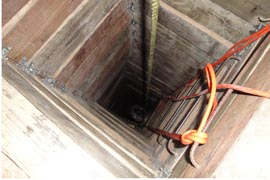Cronkite News has moved to a new home at cronkitenews.azpbs.org. Use this site to search archives from 2011 to May 2015. You can search the new site for current stories.
Officials: High-tech border tunnels take money, time and engineering help
Editor’s Note: A previous version on this story incorrectly stated the location of a tunnel found this summer in Yuma County. That tunnel came up in San Luis, Ariz. The story has been updated to reflect the correction.
WASHINGTON – Drug tunnels are not a new problem at the Southwestern border, but authorities say the number of sophisticated tunnels may be.
Since November 2010, authorities have seized four complete “sophisticated” tunnels into San Diego, which featured everything from lighting to ventilation and electric rail systems for smuggling drugs.
And on July 12, the Drug Enforcement Administration said it had found a fully operational tunnel in the Yuma County town of San Luis that stretched 240 yards and was tall enough at some points for a 6-foot person to stand up in.
The sophisticated tunnels are a new wrinkle to an old problem: Authorities have found 150 drug tunnels along the border since 1990, with most in the last 11 years. Many of those tunnels were incomplete. Fewer still are sophisticated.
But based on the professionalism of the work, mining experts have told federal law enforcement officials that they believe drug cartels are hiring engineers or miners to advise them on the sophisticated tunnels.
“We’ve got people that are mining experts say that at some point someone with a background in mining or engineering” had a hand in the tunnels, said Jose Garcia, deputy special agent for the Homeland Security Investigations office in San Diego.
Garcia, who oversees a tunnel task force, said there are three types of drug tunnels: rudimentary, infrastructure and sophisticated.
Rudimentary tunnels may be nothing more than a simple hole under a border fence that is only big enough to slip drug packages through.
Infrastructure tunnels are like those in Nogales that use part of a storm drainage tunnel to get under the border. They are still relatively crude and may amount to little more than crawl spaces.
Sophisticated tunnels, on the other hand, often have ventilation and lighting and are much longer, usually spanning hundreds of yards. They may have anything from railcars to elevators and are sometimes big enough for an average person to walk through without stooping.
The engineering challenges in building such a tunnel are considerable. Just making sure they are straight can be a challenge.
“There’s a lot of things that don’t work properly underground,” including GPS, said Garcia. An engineer would be able to advise tunnelers in navigation, leading to a relatively straight tunnel at long distances.
Engineers above ground may also use a type of scanner to find the best spots to tunnel, said Ramona Sanchez, a DEA spokeswoman. That includes finding the right soil to dig in.
“Anyone in their right mind is probably going to tunnel, preferentially, through soft alluvial deposits of sand and gravel,” said Don Burt, a professor at Arizona State University’s School of Earth and Space Exploration.
But for all the engineering work, the actual digging can be pretty low-tech, academics and law enforcement officials said.
“This could be done with little more than a pick and shovel,” Burt said in an email.
Garcia said authorities often find spades and other tools, occasionally pneumatic-powered tools, at tunnel sites.
No more than a handful of workers would likely be involved in the tunneling. Tunnels are not very wide with only space enough for one person to comfortably stand, let alone dig.
Rajive Ganguli, a professor of mining engineering at University of Alaska Fairbanks, said he could see the possibility of one or two guys, cramped and digging at the front of the mine with hand tools.
“I would imagine they’re wheelbarrowing the dirt,” which could involve another worker or two, he said. “It could be people doing that on rotations.”
Burt guesses that at any point in the process, “one person might be excavating, another timbering, and another (or several people) mucking and hauling (moving the dirt away). An equivalent number might be resting.”
Workers may be blindfolded on their way to buildings where the tunnels start, to keep the location a secret, Garcia said, and may sleep there until the tunnel is finished.
Once the digging starts, there are other issues to worry about: a tunnel collapse, air circulation and flooding among them.
Tunnels must be shored up to keep from collapsing, but the extent of bracing varies based on what the tunnel is being dug through, officials said.
Soft rock makes sense for digging, but too soft can be a bigger problem, said Paul Knauth, another professor at ASU’s School of Earth and Space Exploration. It is more prone to collapse.
A common method of shoring up tunnels is with timber, but steel and concrete are also options, authorities said. Plywood may line tunnel walls as well, in conjunction with other materials.
Ganguli said it does not take much to shore up a tunnel, since “they’re quite strong” naturally.
“It’s when you try to make them too wide that problems arise,” he said.
One distinctive feature separating sophisticated tunnels from others is ventilation, Garcia said.
While the San Luis tunnel used ductwork along the ceiling, Ganguli said fans could be used near the tunnel’s entrance to circulate air.
Authorities estimate the tunnels take anywhere from six months to a year to complete at a cost of $1 million to $2 million each.
But they could be worth the investment for the drug cartels that can afford them: Literally tons of drugs can be moved quickly through a sophisticated tunnel.
“For them, (cartels) it’s all about risk and odds,” Garcia said.








